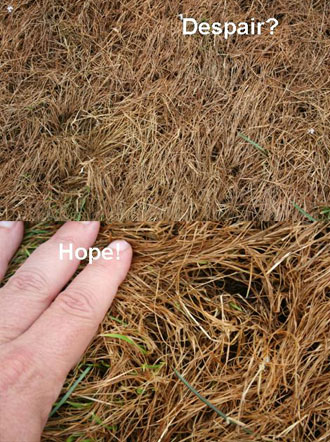Lawn Recovery from Drought
Given the hit and miss nature of summer thunderstorms, many non-irrigated cool-season lawns in the mid-Atlantic enter summer dormancy following periods of 2 or more weeks of high heat, low humidity, and little to no rainfall. Just like winter dormancy in warm-season grasses, summer dormancy of cool-season grasses involves a loss of green color. What are appropriate strategies for water management when extended drying conditions arrive?
First, consider the health of the turf prior to the drought. Even warm-season grass growth will slow (possibly accompanied by some color loss) under extreme moisture duress, but remember, these grasses are adapted to these types of conditions and they almost always survive. It is the cool-season turf that warrants the most concern in summer moisture management. What condition was your lawn before moisture stress arrived? If you are fortunate enough to have a great soil and overall good growing conditions that produce a reasonably healthy lawn, then a suitable management strategy is to simply refrain from irrigating the turf and allow the grass to enter summer dormancy. Expect a quick rebound in greening when significant rains finally arrive. Established turfgrasses are amazingly persistent under low moisture conditions and require less water to survive than trees and most other ornamental landscape plants.
But what if your turf was already struggling and/or is a new establishment before the drought arrived? For this situation, supplemental irrigation is essential if your goal is to do everything possible to prevent massive turf loss. A turf with a very weak root system does not have the ability to withstand extreme moisture duress. The standard rule of thumb to apply 1” of water per week is suitable for most situations, but during extreme drying periods, even this amount of water is likely not enough. Irrigate as early in the morning as possible and apply the water according to what your soil will accept; run-off is a waste, both economically and environmentally.
How do you know if the turf is going to recover? Within a few days (and often as soon as the next day) of the rain event, brush away the tops of the brown leaves and look into the base of your turf canopy. Recovery will be indicated by seeing two things: a) the emergence of green tissue at the base of those ugly brown leaves on the surface and b) new leaves emerging from the growing points of the plant. A picture of turf ‘during’ and the first day ‘after’ (i.e. the recovery) the breaking of the drought accompanies this podcast on the webpage of Turf and Garden Tips.
What can you do for the rest of the summer to help your lawn? Keep those mowing heights high (3+”) and/or stay off the turf completely if it is under stress. And don’t apply nitrogen fertilizer until temperatures have moderated in the fall. If you lose grass (and in this climate, that is always a possibility) be prepared for reestablishment this fall by reviewing and choosing a superior grass blend suited for your area.



